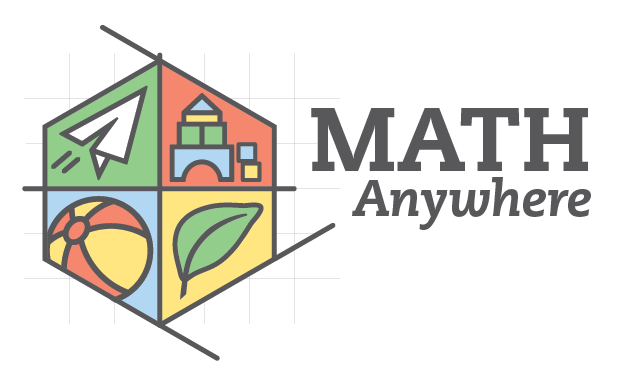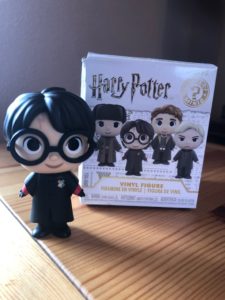Do you remember your child’s first word? Or maybe you’ve heard about the first words you used early on in life?
My parents tell me the first sentence I uttered from my high-chair was “Hi, man! Or was that a woman?” as a neighbor with flowing 80’s metal hair passed by the kitchen window. I know other things about my early literate life- my favorite book was The Little Engine that Could, I liked to listen to Little Toot on the record player, and my favorite story to hear at bedtime was The Lion and the Mouse (yes, I see a theme). But, I can’t tell you what math ideas I was tinkering around with at the same age. It’s not something anyone noticed, or remembered to share with me later.
I don’t think my parents are that different from most grown-ups. We are really good at noticing and acknowledging new words and language kids are taking on as they grow. But do we pay attention to early math learning in the same way?
By the time I had my own son I was working in education as a math specialist, but without a background in early learning I felt clueless about these earliest years. I certainly didn’t have time to read-up on early math as a busy working mom. So I just started noticing- paying attention to moments I thought might be math-y, even if I couldn’t exactly describe why, yet.
These moments happened in lots of situations I didn’t expect to be mathematical. One night we were reading before bed. We read lots of Sandra Boynton (I can still recite most on demand) and Blue Hat, Green Hat was up next.

Mom: “Which do you like better, letters or numbers?”
Kid: “Letters. Green hat has one more.”
I think he counted, maybe he visually compared. In any case my son was quantifying the letters on the cover of his book- something I wouldn’t have thought to do. Bedtime is book time, after all, time for reading and telling stories. And if I was asked to pick out the math ideas in this book I would have thought about attributes (color) or position, but not quantity. Children notice so much more than we do; by listening to their ideas we can often see something new.
I realized in that moment that one of the simplest things I could do is just start noticing what my son was noticing. It was late, well past bedtime, and I just wanted to get finished with this “one last book.” It wasn’t the right time to talk about his math idea, but by noticing I was starting to gain a sense of this little mathematician living in my home.
So I set out to notice. Inside, outside, playtime, lunchtime- I started asking myself, “What is the math in this situation? What is my son paying attention to now?” Thinking about every situation as novel and unique became mentally challenging very quickly. So I shifted gears and started thinking about simple math categories I could look for in any situation.

- Quantity– Is he paying attention to how many, or how much?
- Position– As he plays is he going under, in, on, or behind?
- Shape- Does he ask for the one that is round, or pointy?
- Size– Is he talking about ‘tiny’ or ‘huge,’ or ‘too small’ or ‘too tall’? Does he notice ‘shorter’ or ‘longer’?
I think about how quantity, position, shape, and size are being used during play, or to communicate. I see him comparing, sorting, or making patterns based on these qualities. With just a few categories to think about, it became easy to notice everyday mathematical moments while we were doing just about anything.
When he is older, I will be able to talk with my son about his favorite books, the bedtime stories he begged to hear most. I will also be able to share what kinds of math-y things he was up to through the years.

 Mom: [gives Cal a plate with one biscuit]
Mom: [gives Cal a plate with one biscuit]

 To market anything to the 10 and under crowd these days all you need to do is add some big eyes and the element of surprise. For my son (10) and my niece (8) this holiday Harry Potter Mystery Mini-figures became the obsession. With one figure each in hand we started our seven store sold-out toy search for more. I eavesdropped in on their backseat chatter as we traveled from store to store.
To market anything to the 10 and under crowd these days all you need to do is add some big eyes and the element of surprise. For my son (10) and my niece (8) this holiday Harry Potter Mystery Mini-figures became the obsession. With one figure each in hand we started our seven store sold-out toy search for more. I eavesdropped in on their backseat chatter as we traveled from store to store.
 The back of the box kept them occupied as they began to categorize the figures into four groups: 1) common – 1/6 odds 2) uncommon- 1/12 odds 3) rare – 1/24 odds and 4) epic – 1/36 odds. They went on to discuss their ideas about how many you would have to buy to get all 12 figures in this series. They also had boxes from 2 different series, which both included Harry Potter, of course. “How many Harry’s would you get if you tried to collect all the figures?” they wondered. And, “What are the chances we both get an ‘epic’?” and “What are the chances we get the same figure?” Somehow, nobody but me was wondering, “How many stores will we have to visit?” or “How many miles have we covered so far?” Occasionally they turned to the calculator on my phone to work out some of their reasoning. I have no idea if their math was correct. This is partly because my attention was on the road, but also because it didn’t really matter to me in that moment if it was. This was a mathematical conversation between two kids who were motivated to explore this situation. What more can I ask? I work hard to be patient and accepting of math ideas, trusting that correct methods will show up with time. I don’t need to do anything in this moment, but listen. Even by asking a question I might run the risk of derailing the conversation, or zapping their energy.
The back of the box kept them occupied as they began to categorize the figures into four groups: 1) common – 1/6 odds 2) uncommon- 1/12 odds 3) rare – 1/24 odds and 4) epic – 1/36 odds. They went on to discuss their ideas about how many you would have to buy to get all 12 figures in this series. They also had boxes from 2 different series, which both included Harry Potter, of course. “How many Harry’s would you get if you tried to collect all the figures?” they wondered. And, “What are the chances we both get an ‘epic’?” and “What are the chances we get the same figure?” Somehow, nobody but me was wondering, “How many stores will we have to visit?” or “How many miles have we covered so far?” Occasionally they turned to the calculator on my phone to work out some of their reasoning. I have no idea if their math was correct. This is partly because my attention was on the road, but also because it didn’t really matter to me in that moment if it was. This was a mathematical conversation between two kids who were motivated to explore this situation. What more can I ask? I work hard to be patient and accepting of math ideas, trusting that correct methods will show up with time. I don’t need to do anything in this moment, but listen. Even by asking a question I might run the risk of derailing the conversation, or zapping their energy.
